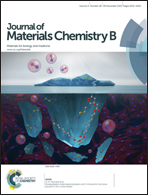Nanoparticle phosphate-based composites as vehicles for antimony delivery to macrophages: possible use in leishmaniasis†
Abstract
Pentavalent antimonial drugs such as N-methylglucamine antimonate (Glucantime®) are used for treating leishmaniasis but produce severe side effects, including cardiotoxicity and hepatotoxicity. We characterized the physicochemical properties of 3 nanoparticle phosphate-based composites (NPCs; NPC0, NPC3, and NPC5) as Sb(V) carriers for specifically targeting macrophages and reducing systemic side effects. NPCs were synthesized in liquid media and sterilized at 25 kGy before use. Macrophage viability and NPC toxicity, independent of Sb uptake, were evaluated to assess NPC safety in visceral leishmaniasis treatment. NPC zeta potential, conductivity, diameter, Sb content, and crystallinity were determined using electrophoretic light scattering, scanning electron microscopy (SEM), conductance, graphite furnace atomic absorption spectrometry (GFAAS), and X-ray diffraction, respectively. In vitro NPC cytotoxicity against murine peritoneal macrophages was evaluated using MTT assays, and Sb amounts internalized by macrophages were determined using GFAAS. The rate of macrophage infection caused by Leishmania infantum was assayed in vitro, by using Glucantime® as a reference drug. NPCs featured negative zeta potentials (−15.5 to −19.5 mV), mean diameters around 180 nm, and a low dissolution constant in Milli-Q water (<0.0197 mS cm−1), and were prepared using 0.0 (NPC0) to 36.2 μg mL−1 Sb (NPC5). NPC5 exhibited characteristic crystalline peaks resembling mopungite, but other NPCs exhibited predominantly amorphous structures. Cell viability was not markedly affected at any NPC concentration tested. Light microscopy, SEM, and GFAAS data revealed NPC internalization and intracellular Sb retention. Amastigote infection was reduced by both Sb-containing NPC3 and Sb-lacking NPC0, but NPC3 was more effective. These data indicate the potential of NPCs as Sb nanocarriers for specifically targeting macrophages and lowering Sb dosage without reducing leishmanicidal activity.


 Please wait while we load your content...
Please wait while we load your content...